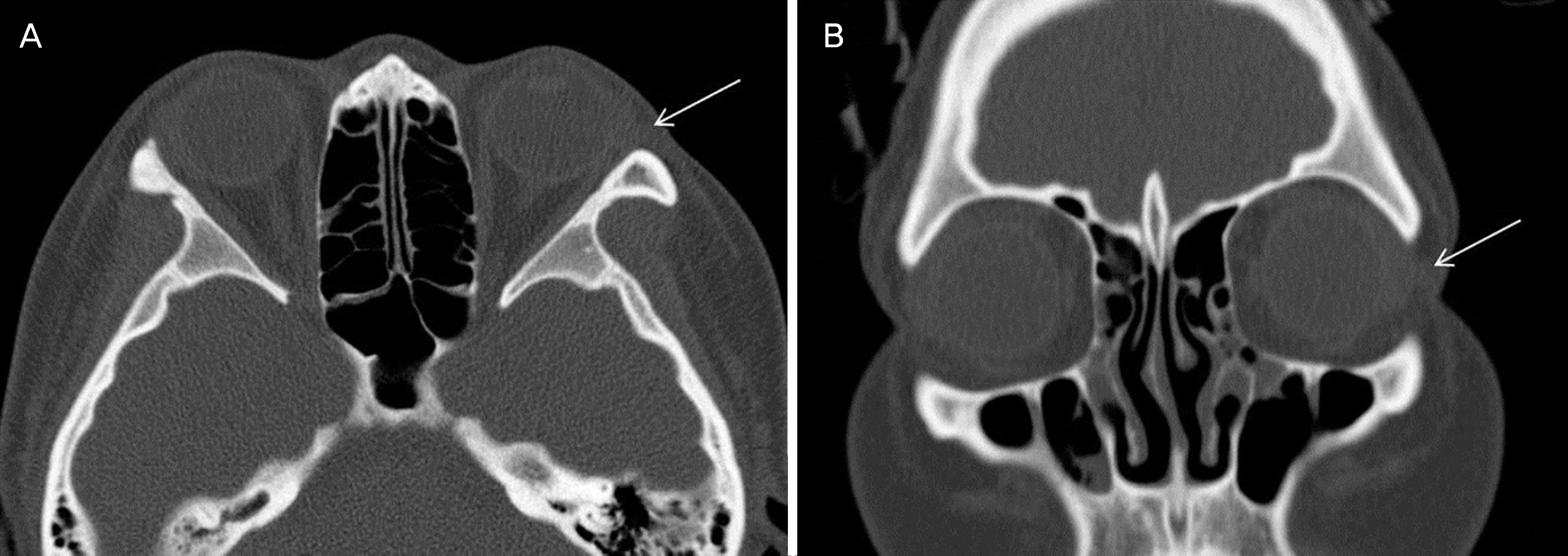Abstract
Purpose
We report our experience with a case of orbital lymph node which has not been previously reported in the Republic of Korea.
Case summary
A 24-year-old female patient with no underlying disease visited our hospital with a 2-month history of a mass at the lateral side of the left upper eyelid. On physical examination, a round, well-defined subcutaneous mass was palpable, and pain, swelling or a skin change were not reported or seen. The appearance, location, and imaging findings of the mass were suspected to be dermoid, and excisional biopsy was performed for accurate diagnosis and treatment. The 1.0 × 0.7 cm-sized, round-shaped and brown-colored mass was excised. The mass was well-defined but in the posterior part; it was attached to the periosteum. The mass was finally diagnosed as a lymph node with lymphadenitis by histopathological examination. No recurrence or new lesion was observed after surgery, and the patient did not complain of abnormal symptoms.
Conclusions
A Complete orbital lymphoid tissue has not yet been found in the orbit, and lymph nodes are known to be absent. However, as in this case, when an orbital mass is observed, the possibility of lymph node should be considered and histopathological examination should be performed to confirm it.
References
1. Turvey TA, Golden BA. Orbital anatomy for the surgeon. Oral Maxillofac Surg Clin North Am. 2012; 24:525–36.

2. Duke-Elder S, Wybar KC. A System of Ophthalmology. 1st ed.2. London: Henry Kimpton;1961. p. 479.
4. Shields JA, Kaden IH, Eagle RC Jr, Shields CL. Orbital dermoid cysts: clinicopathologic correlations, classification, and management. The 1997 Josephine E. Schueler Lecture. Ophthalmic Plast Reconstr Surg. 1997; 13:265–76.
5. Shields JA, Augsburger JJ, Donoso LA. Orbital dermoid cyst of conjunctival origin. Am J Ophthalmol. 1986; 101:726–9.

7. Nugent RA, Lapointe JS, Rootman J, et al. Orbital dermoids: abdominals on CT. Radiology. 1987; 165:475–8.
8. Wolter JR, Roosenberg RJ. Ectopic lymph node of the orbit abdominal a lacrimal gland tumor. Am J Ophthalmol. 1977; 83:908–14.
9. Cockerham GC, Jakobiec FA. Lymphoproliferative disorders of the ocular adnexa. Int Ophthalmol Clin. 1997; 37:39–59.

10. Coupland SE, Krause L, Delecluse HJ, et al. Lymphoproliferative lesions of the ocular adnexa. Analysis of 112 cases. Ophthalmology. 1998; 105:1430–41.
11. Uehara F, Iwakiri N, Ohba N. A twenty-year review of orbital tumor. J Eye. 1995; 12:1177–9.
13. Chesney PJ. Cervical lymphadenopathy. Pediatrics in Review. 1994; 15:276–84.
Figure 1.
Clinical photograph. (A) 0.4 × 0.5 cm sized movable mass (black arrow) is seen on the lateral side of the upper eyelid. (B) Slightly elevated mass (black arrow) is seen at lateral view photograph.

Figure 2.
Preoperative non enhanced computed tomography images. (A) Axial view image. The white arrow indicates a mass. (B) The white arrow indicates a mass at coronal view image.

Figure 3.
Photography of the removed mass. (A) An approximately 1.0 × 0.7 cm sized mass was excised. (B) Microscopic image of the lymph node under a light microscope (hematoxylin and eosin stain, ×10). A node consists of two main regions germinal center in cortex (black arrow) and medullar (white arrow). (C) Follicle with germinal center (hematoxylin and eosin stain, ×100).





 PDF
PDF ePub
ePub Citation
Citation Print
Print


 XML Download
XML Download